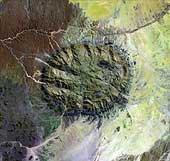|
COMETS EARTH JUPITER KUIPER BELT MARS MERCURY METEORITES NEPTUNE OORT CLOUD PLUTO SATURN SOLAR SYSTEM SPACE SUN URANUS VENUS ORDER PRINTS
PHOTO CATEGORIES SCIENCEVIEWS AMERICAN INDIAN AMPHIBIANS BIRDS BUGS FINE ART FOSSILS THE ISLANDS HISTORICAL PHOTOS MAMMALS OTHER PARKS PLANTS RELIGIOUS REPTILES SCIENCEVIEWS PRINTS
|
Related Documents
Download Options
Rising unexpectedly from the heart of the Namib Desert in northern Namibia, the Brandberg Massif is an exhumed granite intrusion dating to some 120 million years ago. It rises to 2,606 meters (8,550 feet) and is higher than any other feature for hundreds of kilometers. Unique plant and animal communities thrive in its high-altitude environment, and prehistoric cave paintings decorate walls hidden in its steep cliffs. Slightly south and to the west of the Brandberg is the much-eroded Messum Intrusion. Both of these intrusions reflect a period of extraordinarily widespread geological unrest in the Earth's history, which preceded the opening of the Atlantic Ocean and the effusion of vast volumes of basaltic lavas of the Karoo formation that form the Drakensberg plateau. Karoo lavas are exposed immediately to the west of the intrusion. Rocks forced aside by the upward movement of the intrusion are visible encircling the margin of the Brandberg, tilted sharply upward. Ancient gneisses, distinguished by their lineated texture, are conspicuous along the dry river valley in the center of the frame. The existence of a set of lavas in South America of the same age and type as those of the Karoo was used for many years by some geologists as strong evidence that Africa and South America had once been united. However, their arguments were not widely accepted until geophysical data demonstrated the reality of plate tectonics. |
